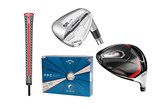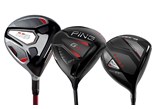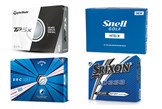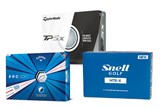9 Equipment fixes to help get the most out of your game
Published: Last updated:
Nine equipment fixes to help you get the most out of your game
Struggling on the course with your driver? Can’t seem to create a consistent putting stroke? It might be time to upgrade what’s in your golf bag.
As part of our Fast Fixes series, TG’s Equipment Expert Simon Daddow talks you through nine simple and effect ways you could change your gear to get the most out of your golf bag… before you’ve even got to the course.
Replace your 10-year-old driver
Research suggests golfers update their driver every five years or so. If your driver is much older than that, you’ll likely see substantial gains in ball speed, dispersion and carry by switching to a new one.
Our old v new driver test last year saw a 2mph ball speed and 12-yard distance gain comparing a five-year-old TaylorMade SLDR against the latest model, which would mean hitting at least one less club into greens. The difference will be even greater as the driver gets older. Make sure you get custom fitted, too.
Related: Best Drivers for Beginners and High Handicappers
Regrip your clubs
When was the last time you changed your grips? Worn or slick grips, or ones that are too big/ small for your hands, can have a major impact on your scores. General usage, oils on your hands, UV light, dirt and other natural elements will wear down rubber grips, just like a car’s tyres.
Over time, grips lose their tackiness and traction and the more you play, the more you should replace your grips. Holding a slick grip tighter cuts club speed and costs distance. Worn grips may also slip, causing a loss of accuracy. If a grip’s too big for you, there’s an adage that your hands will struggle to square the clubface at impact. Whereas if the grips are too small, there’s a danger that your hands will be too active and initiate an early release.
Try a cavityback wedge
Cleveland are the major players when it comes to cavity-back wedges, and their arguments for more golfers using them are strong. They say most wedges have been designed with a topdown approach, which means tour players get wedges to suit their games, but club golfers miss out on attributes which suit theirs.
In our tests, Cleveland’s CBX 2 wedge was three or four yards more accurate than a tourstyle model; that’s nine-12 feet, which could mean the difference between holding an approach on the edge of a green or tumbling off and making bogey or worse.

Get a putter that’s the right length
Ping say that eight out of 10 golfers are using the wrong length putter. Ping’s tour players use putters between 32 and 36 inches, yet putters are traditionally sold in either 34in or 35in lengths, so it’s not surprising so many of us get it wrong.
The wrong length putter makes it difficult to putt consistently, as putts will often be hit off centre which leads to not only distance control issues but accuracy problems, too. Factor in how you use the putter more often than any other club and you can see why it’s so important to get it right.
Did you know that 84% of missed putts over five feet finish short? Or, that your typical drive is nearly 30 yards shorter than your Sunday best drive? These are just two intriguing statistics thrown up by stat tracking technology.
Systems like Shot Scope and Arccos use microchips and GPS to track how far and where you hit every club in a round, building a vast array of stats you can use to identify things you can do better – so you can then improve them.

Choose the best ball for you
Our recent robot test revealed a 10-yard difference (driver) between the longest and shortest balls on sale. Our advice is set yourself a budget, then look at the options at that price point. These are our four favourites.
Tour level: If you’re happy to pay for a tour ball our numbers say TaylorMade’s TP5x (the only ball we tested to average 300 yards carry with the driver) is a great option as it’s accurate and gives up little spin v the highest spinning wedge ball
Club golfer: Callaway’s ERC Soft is especially low spin with the driver, which makes it long, without giving up huge amounts of spin on iron and wedge play. You also get Triple Track alignment lines, to help you set up square
Mail order: Mail order golf balls have sprung up because there’s lots of profit margin in tour level balls. Our results show how Snell’s MTB-X is very closely matched to the Titleist Pro V1x, yet they’ll cost you £22 a dozen less.
Under £25 a dozen: Lots of club golfers could do much worse than investing in a few dozen Srixon AD333. They give up virtually nothing against a Pro V1 and, thanks to the lower cost, you’ll be able to afford to play the same ball all year.

More distance? Try lower lofted irons
Cranking lofts (where brands essentially turn a 7-iron into a 6-iron) to add ball speed and distance hasn’t had the best of reputations over the years, as shots typically fly lower with less spin, which makes it difficult to stop them on a green. But some of the latest strong-lofted iron models are better at flighting shots higher with more spin than ever before.
Some of the change comes down to new technology and how heads react at impact; lighter, higher-launching shafts play a part, too. Strong lofts aren’t for everyone; if you struggle to flight shots high from the turf they’re probably not worth considering. But for golfers who seriously want to add distance to their iron game and don’t have an issue launching shots high, they can be a revelation.
Try a draw biased driver
Modern draw drivers are a revelation! They’re branded up in exactly the same way as any normal driver, meaning you don’t look like a hacker before you’ve even teed up. Gone are the days of mega closed faces which look dreadful at address and in their place are cleverly disguised draw models which have enough mass located in the heel to help you stay away from the right side of the golf course (right handers).
Ping’s G410 SFT and TaylorMade’s M6 D-Type are among our favourites, and if you’ve got a moderate swing speed there’s even a draw model aimed at you, the offset Cobra F-Max Superlite.

Try a counterbalanced putter
If you’re at the end of your tether with a wonky putting stroke why not give a counter-balanced putter a try? Extra weight in the grip end (which is above the hands) improves overall MOI stability, which helps iron out kinks in a putting stroke. The real beauty nowadays is that you don’t need to invest in a whole new putter to get the counter-balanced effect.
The clever engineers at SuperStroke have built CounterCore into each of the brand’s new Traxion putter grips. It means you get a new putter grip, but can also fiddle with 25g, 50g and 75g weights in the top of the grip to give the effect or feel you’re after.






